|
|
|
Sort Order |
|
|
|
Items / Page
|
|
|
|
|
|
|
| Srl | Item |
| 1 |
ID:
116345
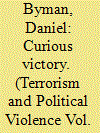

|
|
|
|
|
| Publication |
2012.
|
| Summary/Abstract |
The article examines Israel's successes and failures during the Second Intifada. It argues that Israel's advances came from an effective counterterrorism campaign involving a mix of military operations, defensive measures, and in particular improved intelligence gathering. Domestic resilience also proved strong in the face of a brutal terrorism campaign. Yet long-term victory remains elusive for Israel. Deterrence, always difficult against terrorist groups, is growing harder for Israel. Hamas's control of Gaza, and the mistrust and hatred sown during the Second Intifada, have hindered a political deal between Israel and moderate Palestinians. Much of what went into successful counterterrorism, notably the security barrier and the aggressive campaign of raids and arrests, does not jibe with most visions of what peace would look like and makes a deal harder to achieve. To make a peace deal work, Israeli counterterrorism must change, with measures including relocating parts of the security barrier, bolstering moderate Palestinian politicians, and working with, as opposed to undermining, Palestinian security forces in the West Bank.
|
|
|
|
|
|
|
|
|
|
|
|
|
|
|
|
| 2 |
ID:
120332
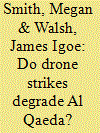

|
|
|
|
|
| Publication |
2013.
|
| Summary/Abstract |
The United States has used unmanned, aerial vehicles-drones-to launch attacks on militants associated with Al Qaeda and other violent groups based in Pakistan. The goal is to degrade the target's capacity to undertake political and violent action. We assess the effectiveness of drone strikes in achieving this goal, measuring degradation as the capacity of Al Qaeda to generate and disseminate propaganda. Propaganda is a key output of many terrorist organizations and a long-standing priority for Al Qaeda. Unlike other potential measures of terrorist group activity and capacity, propaganda output can be observed and measured. If drone strikes have degraded Al Qaeda, their occurrence should be correlated with a reduction in the organization's propaganda output. The analysis presented here finds little evidence that this is the case. Drone strikes have not impaired Al Qaeda's ability to generate propaganda.
|
|
|
|
|
|
|
|
|
|
|
|
|
|
|
|
| 3 |
ID:
141297
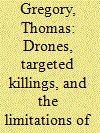

|
|
|
|
|
| Summary/Abstract |
The debate about drones has largely taken place on a legal terrain with various politicians, lawyers, and activists all seeking to establish whether or not targeted killings are legal under the existing framework of international law. In particular, they have raised concerns about the geographical and temporal scope of the “war on terror,” the legal status of those being targeted and whether or not these strikes can be considered discriminate, proportionate, and necessary. The aim of this article is not to settle these legal questions once and for all but to think about the limitations of framing the use of drones as a legal issue rather than an ethical, moral, or political concern. I will argue that the emphasis on international law distracts attention away from the horrors of war by masking the pain and suffering that is caused in favor of technical debates about the application of particular legal codes. Drawing on the work of Judith Butler, Adriana Cavarero, and Elaine Scarry, I will argue that we need to turn our attention back to the embodied experiences of those affected.
|
|
|
|
|
|
|
|
|
|
|
|
|
|
|
|
| 4 |
ID:
139493
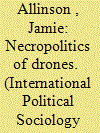

|
|
|
|
|
| Summary/Abstract |
The rapid increase in the use and capabilities of Unmanned Aerial Vehicles (UAVs), or “drones,” has led to debates on their place in US strategy, particularly their use in assassination missions, or so-called targeted killings. However, this debate has tended to focus narrowly on two questions: first, whether the US use of UAVs to assassinate its enemies, including US citizens, is legal, and second, whether drones should be given the autonomy to decide when to kill humans. This paper uses the concept of “necro-politics”—the arrogation of the sovereign's right both to command death and to assign grievable meaning to the dead—as it emerges in the work of Achille Mbembe to criticize the assumptions of these questions. It is argued that debates over endowing drones with the autonomy to kill humans assume that the current human operators of drones work outside of the context of racial distinction and colonial encounter in which they already make decisions to kill. The paper supports this argument with reference to the text of a US investigation into a strike which killed civilians in Uruzgan province, Afghanistan.
|
|
|
|
|
|
|
|
|
|
|
|
|
|
|
|
| 5 |
ID:
153885


|
|
|
|
|
| Summary/Abstract |
How do human rights groups prevent the normalization of practices they find troubling? Existing international relations research provides insights into how states resist the new norms human rights activists introduce into the global arena. But it tells us less about how governments themselves promote norms and how activists push back against this advocacy. This article explores this issue by examining the interplay between Human Rights Watch (HRW) and the United States around the emerging norm of targeted killing. It argues that Bin Laden’s death opened a window of opportunity for the potential emergence of a targeted killing norm, with the United States as its norm advocate. To prevent its emergence, HRW deployed some of the same strategies states have used to suppress the emergence of norms they dislike. In illustrating these dynamics, this article helps us better understand why some norms rise, why some fall, and why they might change over time.
|
|
|
|
|
|
|
|
|
|
|
|
|
|
|
|
| 6 |
ID:
158006


|
|
|
|
|
| Summary/Abstract |
Targeted killings have become a central tactic in the United States' campaigns against militant and terrorist groups in the Middle East, Asia, and Africa. Both ‘demand’ and ‘supply’ factors explain the rise of targeted killings. Demand for targeted killings increased as the United States faced new threats from militant groups that could not be effectively countered with conventional military force. Concerns about the political consequences of long-term military involvement overseas and American casualties led political leaders to supply more targeted killings. The conclusion discusses how this tactic may have unintended consequences as other states follow the United States use of targeted killings.
|
|
|
|
|
|
|
|
|
|
|
|
|
|
|
|
| 7 |
ID:
079527
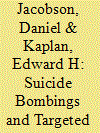

|
|
|
|
|
| Publication |
2007.
|
| Summary/Abstract |
This article develops sequential game models for key operational terrorist (how often to attack) and government (how often to execute targeted killings) decisions taken during a (counter-) terror campaign such as the second intifada. Key results include the following: The government initiates targeted killings when the marginal number of Israeli civilian lives saved from prevented terror attacks exceeds the marginal number of Palestinian civilian lives lost in such ``hits''; targeted killings are not employed if they are either ineffective or extremely effective at thwarting terror (since terrorists will not induce their use); even after accounting for downstream terror attacks motivated by prior targeted killings, a civilian casualty-minimizing government can optimally order targeted killings over time; and low-level cycles of violence can occur when the government is more patient than the terrorists, but higher, stable levels of violence result when the terrorists are the more patient players in the game
|
|
|
|
|
|
|
|
|
|
|
|
|
|
|
|
| 8 |
ID:
095227
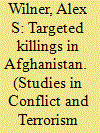

|
|
|
|
|
| Publication |
2010.
|
| Summary/Abstract |
This article examines the coercive and deterrent utility of targeting the leaders of violent, non-state organizations with precision force. Building on the literatures on targeted killings and deterrence theory, this article provides a case study analysis of targeted killings in Afghanistan. Relying on publicly available and semi-private sources, the article presents a comparative analysis of four targeted killings conducted against Taliban leaders. Findings suggest that the eliminations degraded Taliban professionalism, diminished the group's success rates, influenced their selection of targets, and weakened morale. These findings speak to the efficacy of targeted killings in counterterrorism and counterinsurgency and to their value as both counter-capability and counter-motivation operations.
|
|
|
|
|
|
|
|
|
|
|
|
|
|
|
|
|
|
|
|
|